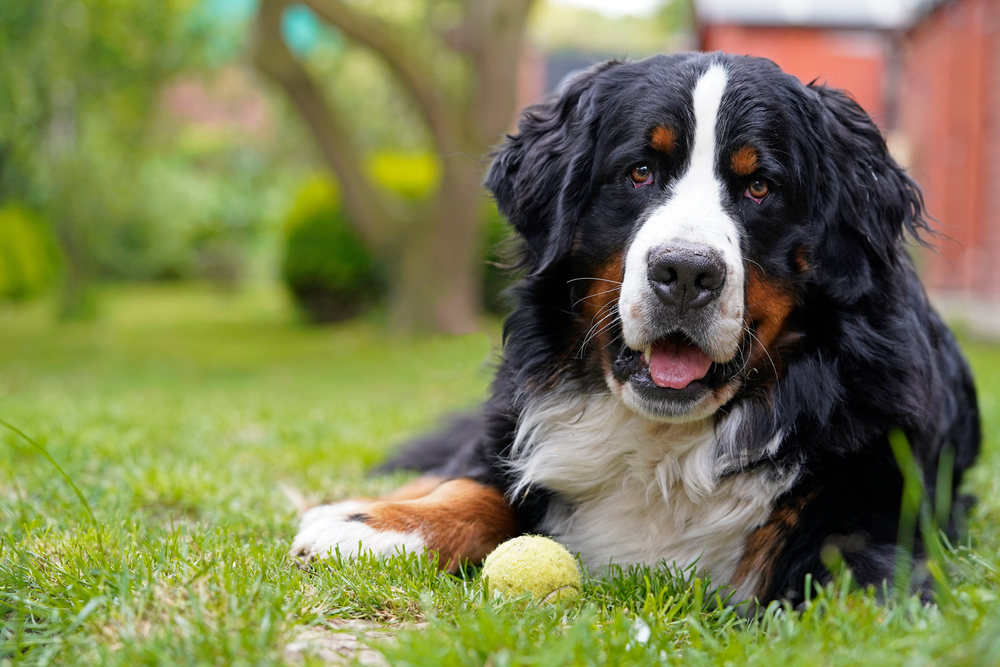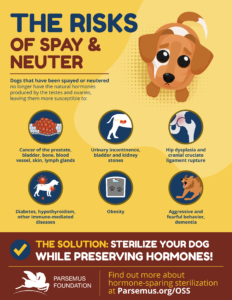
Project Summary: Hormone Restoration in Dogs
- In the U.S. and many other countries, spay and neuter has become standard practice for pet population control and is completed by removal of the sex organs – the ovaries and uterus in females (ovariohysterectomy) and the testes in males (orchiectomy /castration).
- After several decades of widespread spay/neuter practice, research in dogs has found that removal of the sex organs and associated hormones can result in significant health issues for some pets, including cancers and joint disorders.
- Dogs can be sterilized while retaining natural hormones by performing hysterectomy or vasectomy.
- The vast majority of dogs receive a spay or neuter because many pet owners are not aware of health problems that may occur due to loss of natural hormones, and only a small percentage of veterinarians provide hormone sparing sterilization.
- Many dogs sterilized by traditional spay and neuter procedures are at risk of health problems.
- Treatments to restore the natural hormone balance in spayed and neutered dogs are needed to prevent or treat health problems.
- The Parsemus Foundation was an early proponent of individualizing pet sterilization and has served as a repository of information on hormone-sparing sterilization options.
- The first case study of hormone restoration in a castrated dog was published by the Parsemus Foundation.
- The foundation is helping to develop standardized methods of hormone restoration in dogs, providing resources for both pet owners and veterinary practitioners, and maintaining a veterinary directory of providers for alternative sterilization methods and hormone restoration.
Hormone Restoration Project Topics
Hormone loss from spay and neuter: An underappreciated reason for health problems in dogs
Gonadectomy and hormone loss
Over 80% of dogs in the U.S. have had a spay or neuter, which removes the sex organs (called gonadectomy) and associated hormones. About 15 years ago, veterinarians and researchers started to realize that spayed or neutered dogs were more likely to have certain health problems, such as cancer and joint disorders. The amount of research has increased over the years and indicates that a loss of natural hormones can have significant lifelong health implications. For a thorough review of the data on gonadectomy and canine health, see our Hormone-Sparing Sterilization page.
You may expect that a loss of sex hormones would only be related to reproduction. Yet a growing body of research indicates that serious health complications unrelated to the sex organs may occur after spay/neuter. Obesity, urinary incontinence, various cancers, immune-mediated diseases, musculoskeletal disorders, and cognitive and behavior problems are more common in gonadectomized dogs.
This is likely because the natural hormone feedback mechanisms become unregulated in neutered dogs. Research from Dr. Michelle Kutzler of Oregon State University, a veterinary theriogenologist and pioneer in understanding the mechanisms of hormone loss in dogs, indicates that luteinizing hormone (LH) may be the problem. In dogs without natural hormone levels, there is no feedback mechanism to control LH. LH effects many organs throughout the body, and the high levels of unopposed LH likely influence the development of diverse health disorders. These findings support the importance of a balanced hormone system for optimal health.
Gonadectomy has some positive health outcomes as well as reducing pet overpopulation. Gonadectomized dogs are not as likely to have diseases associated with sex organs, such as mammary, ovarian and testicular cancers, pyometra uterine infection, and prostate disorders. And not all dogs will succumb to health problems after being spayed or neutered. There are a complex set of variables that appear to influence the importance of sex hormones, including the age of the dog when spayed or neutered, the breed, the sex of the dog, and its size. Health issues seem to be common in dogs that receive a spay or neuter at a young age and large breed dogs who lose hormones before they finish growing.
To avoid potential health and behavior issues related to spay and neuter, pet owners can choose a hormone-sparing sterilization method, such as vasectomy for males and hysterectomy (also called ovary-sparing spay) for females. For more information, see details on our Hormone-Sparing Sterilization page.
Hormone restoration for dogs that may be suffering from a lack of natural hormones
Most dogs have already received a traditional spay or neuter surgery, removing the ovaries or testes. In fact, pet shelters or rescue organizations usually require that dogs and cats are spayed or neutered before adoption. Some of these pets will develop health or behavior issues due to the loss of natural hormones.
In humans, a loss of hormones due to injury or disease would be treated by hormone therapy to maintain health. This includes treatment with estrogen, testosterone, or other hormones. Couldn’t we supplement the lost hormones in spayed or neutered dogs to treat or prevent health conditions?
While restoring normal hormone levels in spayed and neutered dogs seems like a logical treatment option, it is not a standard veterinary treatment. Very little research has been conducted on this topic. Most published research in dogs is related to urinary incontinence. This is a common problem in female dogs after being spayed, especially large breeds and those spayed at an early age.
Incontinence in females has been treated successfully with various estrogens and gonadotropin-releasing hormone (GnRH) agonists (e.g., deslorelin), and GnRH immunization. These treatments restore urinary continence by reducing luteinizing hormone (LH) concentrations.
One publication in eight male dogs reported treating urinary incontinence with testosterone cypionate (median dose of 1.5 mg/kg intramuscularly every 4 weeks). The treatment worked well for two dogs but was not effective in half of the dogs. However the treatment was considered safe. Other treatments for male dog incontinence include phenylpropanolamine (PPA), estrogens, surgery and anticholinergic drugs. Studies are usually small and medical therapy has not been very effective.
Case study on hormone restoration in a neutered dog
Research on restoring natural hormone levels in dogs after spay or neuter is generally lacking. But a recent case report provides a bit of guidance. Published in Topics in Companion Animal Medicine, this study reviewed the use of hormone restoration therapy in a neutered male dog that had significant health issues shortly after gonadectomy received at seven months of age. Weight gain, loss of mobility due to pain in the right hip, and debilitating fear of strangers significantly reduced the dog’s quality of life.
After three years of standard medical treatments with no significant improvement, hormone restoration was attempted when the dog was about 4 years old. Low testosterone was increased with injectable testosterone cypionate and a weekly subcutaneous dose (0.5 mg/kg) was found to provide a steadier level than a monthly dose. But this dog also had extremely high luteinizing hormone (LH) levels that did not come down to the normal range with testosterone alone. The use of a gonadatropin-releasing hormone agonist implant (deslorelin) effectively reduced LH levels.
Within months, this treatment resulted in improved mobility, stabilized weight, and reduction in fear and anxiety. The dog could run, jump, and visit public parks – things he could not do previously without pain or extreme anxiety. He also accepted the weekly injections happily with positive reinforcement training.
The Parsemus Foundation is often contacted by concerned pet owners seeking to get hormone therapy for their dog. They are often surprised to find that the dog featured in the case study is actually my own pet, Toby. Toby was adopted from a county shelter at 7 months of age and was mandatorily neutered. He showed signs of serious health problems shortly after. As an animal welfare scientist, I knew that his ailments might be due to loss of hormones from being neutered. I researched hormone treatments and worked with Dr. Michelle Kutzler to develop a plan.
I'm thrilled that the hormone restoration treatment was successful! Toby has now been on the treatment for over 3 years. His mobility problems were totally solved, and while he is still shy around strangers, his anxious behavior is manageable."
Linda Brent, PhD
Executive Director of Parsemus Foundation
A call for more research
Since publication of the case report, the Parsemus Foundation has received numerous requests from dog owners for assistance in providing hormone therapy for their dog. But at this time, there is a need for more research to develop standard procedures and determine best practices for canine hormone restoration therapy.
For those interested in attempting hormone restoration therapy, a couple of points are relevant:
- Gonadectomy does not result in health disorders in all dogs, so it is important to work with your veterinarian to rule out other causes if your dog has a health issue.
- Complete hormone testing, including luteinizing hormone levels, prior to and during hormone therapy.
- Keep in mind that dogs on hormone restoration therapy may exhibit behaviors (interest in mating) and health issues (enlarged prostate) more common in intact dogs.
The Parsemus Foundation encourages veterinarians and pet owners to share information on hormone treatments and outcomes by contacting us at info@parsemusfoundation.org. We can assist with financial support for small studies to determine the safest and most effective methods of providing hormones. Hopefully in the near future, larger multi-site studies can be conducted to evaluate the efficacy of hormone restoration therapy on spayed and neutered dogs, so that dogs no longer need to suffer from a lack of natural hormones.
Take Action on Hormone Restoration
For Veterinarians
- If your veterinary clinic offers hormone therapy or alternative sterilization methods, please consider listing in our free directory by filling out the info on the clinic registration form.
- We are seeking veterinarians interested in collaborating on research on the topic of hormone restoration in spayed or neutered dogs. Please contact Parsemus Foundation at info@parsemus.org.
- Check out our Hormone-Sparing Sterilization webpages for much more information the implications of gonadectomy and how to perform vasectomy and hysterectomy (ovary sparing spay). Contact us if you would like to receive more details or to consult with an experienced practitioner.
For Pet Owners
- If you think your dog might be suffering from a loss of hormones, consult a veterinarian who is familiar with the health issues related to spay/neuter, hormone-sparing options, or hormone restoration.
- To find a veterinarian, you can search the Veterinary Directory or check the information at the Dogosterone site (Note: Dogosterone is a program of testosterone treatment for male dogs and has no affiliation with the Parsemus Foundation).
- If you cannot find a provider nearby, you could pass along the information on this website to your own veterinarian and ask if he or she can provide hormone therapy. Direct him or her to the information on this website and email us at info@parsemusfoundation.org if additional assistance/advice is required.
- We recommend that you have LH (luteinizing hormone) measured along with other hormones before and after starting hormone therapy.
- Please let us know if you find a veterinarian who offers hormone therapy and would like to join our directory!
- If you choose to restore your dog’s hormones, consider joining this Facebook group: Training and behavioral advice for Intact Dogs.
- And send us an update on your experience if you and your veterinarian decide to try hormone restoration for your dog. We are collecting information to inform the development of this new treatment area.
Veterinarians Offering Alternative Methods of Contraception
Pet owners:
Looking for a veterinarian willing to perform procedures beyond surgical spay or neuter? Browse our directory of qualified veterinary professionals.
Veterinarians:
Do you offer alternative methods of contraception like ovary-sparing spay and vasectomy? Join our referral directory so new clients can find you.
Additional Resources
Publications on hormone restoration in dogs
- Aaron A, Eggleton K, Power C, et al. (1996).Urethral sphincter mechanism incompetence in male dogs: a retrospective analysis of 54 cases. Vet Rec 139(22):542–6. (Abstract).
- Berry SJ, Coffey DS, Strandberg JD, Ewing LL (1986). Effect of age, castration, and testosterone replacement on the development and restoration of canine benign prostatic hyperplasia. Prostate, 9:295-302. (Abstract).
- Brent L, Lissner EA, Kutzler MA (2021). Restoration of reproductive hormone concentrations in a male neutered dog improves health: A case study. Topics in Companion An Med 45:100565. (Free full text).
- Donovan CE, Weston A, Kutzler MA (2013). Gonadotropin-releasing hormone immunization to treat urethral sphincter mechanism incompetence in a bitch that experienced an adverse reaction to phenylpropanolamine. J Vet Sci Med Diagn, 2:3. (Abstract).
- Mandigers RJ, Nell T (2001). Treatment of bitches with acquired urinary incontinence with oestriol. Vet Rec 149:764-767. (Abstract).
- Palerme J-S, Mazepa A, Hutchins RG et al. (2017). Clinical response and side effects associated with testosterone cypionate for urinary incontinence in male dogs. Am Anim Hosp Assoc, 53:285-290. (Full text).
- Veronesi M, Rota A, Battocchio M, et al. (2009). Spaying-related urinary incontinence and oestrogen therapy in the bitch. Acta Vet Hung, 57:171-182. (Abstract).
- Last updated on December 14, 2023
Tell us what you think
What People Are Saying
I am so thankful for this site. I have referred people to you for years. … I’ve told people about the option of hormone-sparing surgeries and also managing their intact animals with integrity and compassion. I look at your site and tell them about veterinarians near them who can do these surgeries.
Website Visitor
Laparoscopic ovariectomy in cats is safe, can be performed in a comparable amount of time as traditional ovariohysterectomy, and may result in less postoperative discomfort.
Case et al.
With there not being many studies about the benefits of ovariohysterectomy, most evidence extracted from the literature leads us to the misguided conclusion that there is no benefit and thus no indication for removing the uterus during routine neutering in healthy bitches.
Kirpensteijn
The societal practice in the U.S. of dog neutering contrasts with the general attitudes in many European countries, where neutering is commonly avoided and not generally promoted by animal health authorities.
Torres de la Riva, et al.
Based upon the review of the literature, it becomes clear that canine gonads are not merely reproductive organs but critical to endocrine, musculoskeletal, behavior, and antineoplastic health.
Zwida & Kutzler
Recent scientific studies demonstrate that spaying/neutering, particularly before a dog is fully mature, may result in detrimental long-term health impacts. In light of this information, AKC encourages breeders, owners and veterinarians to consult on the appropriateness and timing of spaying or neutering an individual dog.
AKC Position Statement on Spaying and Neutering
About the only positive effect on behavior that seems to result from spaying and neutering is the roughly 68 percent decrease in urine marking.
Stanley Coren Ph.D., F.R.S.C
Thought leaders are beginning to accept that spay and neuter have both positive and negative health consequences that vary by age, gender and breed.
Elaine Lissner
Pet Health News

Analysis of longevity in Rottweilers based on neuter status
A recent publication in Scientific Reports took an in-depth look at longevity in Rottweilers. The authors evaluated the health records of 7,185 Rottweiler dogs from

Understanding hemangiosarcoma in Golden Retrievers
A 2023 study on hemangiosarcoma in Golden Retrievers adds to our knowledge of this common canine cancer. As past studies have shown, the occurrence of hemangiosarcoma

Parsemus’ work on hormone restoration in dogs featured
Parsemus Foundation Executive Director Linda Brent, Ph.D. was recently interviewed by veterinarian Peter Dobias, DVM about the foundation’s research on hormone restoration in dogs. Dr.

Analysis of longevity in Rottweilers based on neuter status
A recent publication in Scientific Reports took an in-depth look at longevity in Rottweilers. The authors evaluated the health records of 7,185 Rottweiler dogs from

Understanding hemangiosarcoma in Golden Retrievers
A 2023 study on hemangiosarcoma in Golden Retrievers adds to our knowledge of this common canine cancer. As past studies have shown, the occurrence of hemangiosarcoma

Parsemus’ work on hormone restoration in dogs featured
Parsemus Foundation Executive Director Linda Brent, Ph.D. was recently interviewed by veterinarian Peter Dobias, DVM about the foundation’s research on hormone restoration in dogs. Dr.

Amici Cannis makes a difference for the people and animals in Ecuador
The Parsemus Foundation is a proud supporter of Amici Cannis, an animal welfare organization working in Ecuador. We’ve known the founder, Dr. Heather Steyn, for




